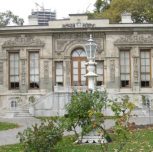The Aynalıkavak Pavilion is located in the Hasköy neighborhood in Kasımpaşa, Istanbul. It is not exactly known as to when it was built, but Evliya Çelebi, the famous 17th century Ottoman traveler and writer, states that it was built during the period of Sultan Mehmed II. Another source says that the pavilion was been built by Admiral Halil Paşa in 1613.
The name, Aynalıkavak Pavilion, comes from the mirrors which were a gift to Sultan Ahmed III after the Treaty of Passarowitz was signed and during which the Republic of Venice was left the Mora Peninsula to the Turks. The pavillion was built on a slope and its garden was decorated with different kinds of trees. One enters the pavillon through the porch and then passes into a wide hall. There are couches covered with silk located at the three corners of the wide hall, and a poem written by Sultan Selim III in gold print is located on the blue painted wall. The land façade sits on two floors and the sea-side façade on three. The pavilion has a divan room and an audience hall (Arz Odası) decorated with several works of calligraphy, nice windows, and mirrors. Its ceiling is covered by a dome.
In the beginning of the 19th century, the Aynalıkavak Pavilion was called the Has Bahçe. During the rule of Sultan Mahmut II it was restored by the architect Kirkor Balyan. It took its present shape during the Reign of Sultan Selim III.
During the Tulip Era, (or Lâle Devri in Turkish), the pavilion hosted many entertainment venues. In addition, it hosted the Aynalıkavak Agreement signed by Sultan Abdülhamid I on January 9, 1784 between the Ottoman Empire and Russia.
The Aynalıkavak Pavilion is presently a palace-museum and houses the Turkish Music Research Center and the Museum of Instruments in its basement.










